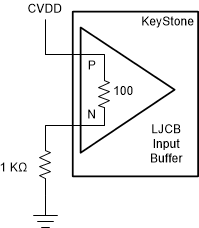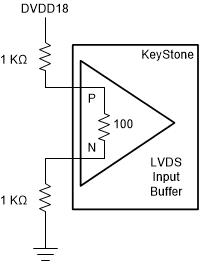SPRACL9 May 2019 66AK2E05 , 66AK2H06 , 66AK2H12 , 66AK2H14 , AM5K2E02 , AM5K2E04 , TMS320C6652 , TMS320C6654 , TMS320C6655 , TMS320C6657 , TMS320C6670 , TMS320C6671 , TMS320C6672 , TMS320C6674 , TMS320C6678
- KeyStone Multicore Device Family Schematic Checklist
5.2.5 Unused Clock Inputs
Any unused LJCB or LVDS differential clock inputs should be connected to the appropriate rails to establish a valid logic level. Unused clock inputs connected to the SerDes/CML in the KeyStone II device should be left unconnected. The recommended connections are shown in Figure 3 and Figure 4. The added 1kΩ resistor is designed to reduce power consumption. The positive terminal should be connected to the respective power rail. For more clarity, see Hardware Design Guide for KeyStone™ I Devices and the Hardware Design Guide for KeyStone II Devices.
 Figure 3. Unused LJCB Clock Input Connection
Figure 3. Unused LJCB Clock Input Connection  Figure 4. Unused LVDS Clock Input Connection
Figure 4. Unused LVDS Clock Input Connection